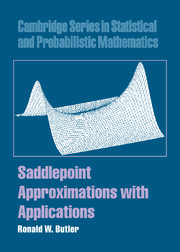Book contents
- Frontmatter
- Contents
- Preface
- 1 Fundamental approximations
- 2 Properties and derivations
- 3 Multivariate densities
- 4 Conditional densities and distribution functions
- 5 Exponential families and tilted distributions
- 6 Further exponential family examples and theory
- 7 Probability computation with p*
- 8 Probabilities with r*-type approximations
- 9 Nuisance parameters
- 10 Sequential saddlepoint applications
- 11 Applications to multivariate testing
- 12 Ratios and roots of estimating equations
- 13 First passage and time to event distributions
- 14 Bootstrapping in the transform domain
- 15 Bayesian applications
- 16 Nonnormal bases
- References
- Index
10 - Sequential saddlepoint applications
Published online by Cambridge University Press: 25 February 2010
- Frontmatter
- Contents
- Preface
- 1 Fundamental approximations
- 2 Properties and derivations
- 3 Multivariate densities
- 4 Conditional densities and distribution functions
- 5 Exponential families and tilted distributions
- 6 Further exponential family examples and theory
- 7 Probability computation with p*
- 8 Probabilities with r*-type approximations
- 9 Nuisance parameters
- 10 Sequential saddlepoint applications
- 11 Applications to multivariate testing
- 12 Ratios and roots of estimating equations
- 13 First passage and time to event distributions
- 14 Bootstrapping in the transform domain
- 15 Bayesian applications
- 16 Nonnormal bases
- References
- Index
Summary
When the joint MGF of (X, Y) is available, the conditional MGF of Y given X = x can be approximated by using the sequential saddlepoint method. Apart from providing conditional moments, this approximate conditional MGF may also serve as a surrogate for the true conditional MGF with saddlepoint methods. In such a role, it can be the input into a singlesaddlepoint method, such as the Lugananni and Rice approximation, to give an approximate conditional distribution. Thus, the resulting sequential saddlepoint approximation to Pr(Y = y|X = x) provides an alternative to the double-saddlepoint methods of sections 4.1-4.2.
Computation of a p-value for the Bartlett–Nandi–Pillai trace statistic in MANOVA provides a context in which the sequential saddlepoint approximation succeeds with high accuracy but the competing double-saddlepoint CDF approximation fails. Among the latter methods, only numerical integration of the double-saddlepoint density successfully replicates the accuracy of the sequential saddlepoint CDF approximation; see Butler et al. (1992b).
Another highly successful application of sequential saddlepoint methods occurs when approximating the power function of Wilks' likelihood ratio test inMANOVA. This example is deferred to section 11.3.1.
Sequential saddlepoint approximation
Suppose (X, Y) is a m-dimensional random vector with known joint CGF K(s, t) where s and t are the respective components. The goal is to use the joint CGF to determine conditional probabilities and moments of Y given X = x.
Information
- Type
- Chapter
- Information
- Saddlepoint Approximations with Applications , pp. 323 - 340Publisher: Cambridge University PressPrint publication year: 2007
